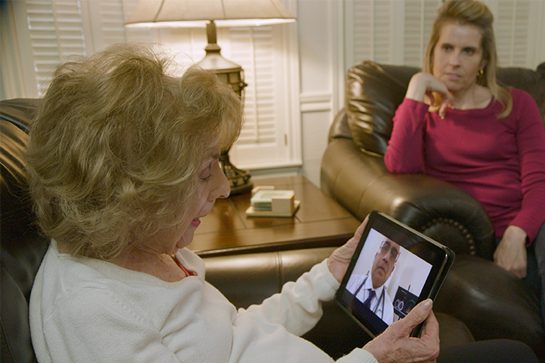Telehealth is one of the newest and most effective tools at improving remote care benefits and empowering rural Medicare beneficiaries to better receive whole person care. Enabling beneficiaries to receive care in the most convenient way possible, sometimes even from the comfort of their own homes, allows them to receive timely care and meet with distant specialists they would not be able to see otherwise. Providers that include telehealth in their plan options are able to position themselves as leaders in overall plan value, innovation, and convenience.
Many providers are leveraging telehealth options to address growing concerns as commercial health plans fall behind other industries in metrics such as convenience and helpfulness. Recognizing the potential of improving the quality of care, states across the country are removing legal barriers that once hindered telehealth initiatives and are working to empower telehealth providers with the legal tools they need to provide safe and secure telehealth options.
In 2017, 64 bills were approved by 34 state legislatures that specifically addressed reimbursement challenges and increased participation in interstate licensure agreements. Additional legislative efforts have also targeted increasing access to behavioral healthcare, introducing telehealth services into schools so students have access to distant mental health and other specialists, and providing aid to those in rural areas where broadband internet may need to be expanded.
One of the states with the greatest shortage of physicians is Mississippi, and lower income patients and those in rural areas are hit especially hard. The primary tool they are utilizing in combatting these challenges is telehealth, and the University of Mississippi Medical Center is leading the efforts. Their Center for Telehealth has a network of over 200 locations to serve a state population that leads the nation in rates for diabetes and heart disease. As telehealth has been expanded, so has access to care for the rural population. There has also been a corresponding increase in continuity of care and whole person care. As consumers gain greater access to preventive care, routine check-ups, and non-critical services are increased, telehealth becomes a critical tool in providing the type of whole person care designed to treat every aspect of patients’ overall health and emotional well-being.
Nebraska is another state using telehealth to improve access to and convenience of care. Recently, BlueCross BlueShield Nebraska expanded an mHealth platform that empowers their beneficiaries with chronic disease to reach their physicians and other providers through multiple communication channels. They also provide support for patients that participate in wellness programs designed to promote preventive care and keep them healthy and out of the hospital.
Massachusetts’ efforts have recently expanded a digital health platform also targeting those with chronic disease, such as diabetes management, as well as offering resources for parenthood guidance and other preventive care options available to employer-sponsored groups.
In Utah, Intermountain Healthcare has adopted telehealth services to allow patients to receive consults in their home as well as other specialty visits. Mike Phillips, Chief of Clinical and Outreach services at IHC, says of their results that “there are cost savings around not transferring someone” between specialists and providers. Their Connect Care Pro Program links patients in rural areas of Utah to Intermountain specialists located throughout the state.
As with most new and innovative technologies, certain challenges are to be expected. The limitations of telehealth are largely financial, such as its reliance on broadband internet technology often not available in rural areas, where it must be installed in order for telehealth services to be provided. Governments may feel reticent to expand telehealth services into rural areas that have poor broadband connectivity, or none at all. Telehealth reimbursement also has payment limitations, such as its services not being reimbursed at the same level as in-person visits.
To address these concerns, thirty-three states have enacted telehealth parity laws to make it financially viable for providers to offer telehealth services. Despite the numerous legislative efforts from several states, Montana—one of the country’s most rural states—closed the door on legislation that would have established telemedicine standards for rural patients. To help overcome these challenges, Federal agencies, such as the FCC, are increasing broadband investments in rural communities in need of telehealth access.
Additional federal assistance is also being provided by the Centers for Medicare and Medicaid (CMS) as they recently rolled out a new agency-wide Rural Health Strategy designed with input from rural providers and patients. These efforts are designed to “apply a rural lens to CMS programs and policies.” Utilizing direct feedback from rural residents as they craft policies regarding telehealth, they are seeking to improve the quality of healthcare while mitigating some of the challenges typically faced by rural health providers in years past.
One challenge CMS continues to grapple with is opioid overuse among Medicare beneficiaries, with 6 of every 1,000 beneficiaries suffering from opioid use disorder. By using telehealth to increase interoperability between prescription drug monitoring programs (PDMPs), CMS hopes to help providers make better-informed prescribing practices by linking physicians across state lines with integrated telehealth technology. New York has implemented a PDMP program now integrated with 25 other states.
With the increased knowledge provided to physicians in providing care, greater availability of rural residents to meet with far away specialists and the added convenience for both patient and provider in receiving more timely care, telehealth has significant potential at improving continuity of care. Social determinants that have impacted efforts in the past to provide whole-person care are being mitigated and eliminated. As telehealth connects patients to a wide range of specialists, they are receiving much needed care for chronic disease, substance use disorder, mental illness, and much more.
Blog Resources



